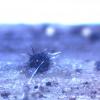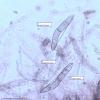
21-12-2025 09:32
Hello.A tiny ascomycete found embedded in wood in

21-12-2025 21:32
Pol DebaenstHello, Garden, Burgweg 19, Veurne, BelgiumOn 10/1

22-12-2025 23:38
Patrice TANCHAUDBonsoir, récolte sur un mur en pierre, apothéci

22-12-2025 00:47
Patrice TANCHAUDBonsoir, récolte à proximité du milieu dunaire

21-12-2025 21:40
Isabelle CharissouBonjour, j'aimerais connaitre les références de

20-12-2025 23:08
Patrice TANCHAUDBonsoir, récolte sur sol sablonneux dans l'arri�

20-12-2025 15:47
Mirek GrycHi.These grew on pine wood that was heavily covere
Hairy black asco
Malcolm Greaves,
05-02-2017 16:11
It had a black globose perithicum with a few very dark and very thick walled hairs. The spores were pale mostly 3 septate and bent. There were one or two othere types of spore found in the squash. The first skittle shaped and the second with 8 septa but I think both could have been introduced.
Can someone at least tell me the family
Thanks.
Mal
Bernard Declercq,
05-02-2017 17:42

Re : Hairy black asco
Dear Malcolm,
You collected most probably a Hilberina. Spore dimensions are close to those of H. dactylina (graminicolous) and H. spaghni (bryophilous) but the spores of these species are geniculate in the lower quarter.
Maybe Andy has a better idea?
Cheers,
Bernard
You collected most probably a Hilberina. Spore dimensions are close to those of H. dactylina (graminicolous) and H. spaghni (bryophilous) but the spores of these species are geniculate in the lower quarter.
Maybe Andy has a better idea?
Cheers,
Bernard
Malcolm Greaves,
05-02-2017 20:24
Re : Hairy black asco
Thanks Bernard
Hilberina certainly looks to be a good bet. The Key in the article in Mycologia 106(3) 2014) by Miller et al keys out quickly to H punctata with the note " H punctata differs from other Hilberina species by its roughened ascospores that are rounded at both ends and curved or bent in the middle. The ascospores lack the pointed attenuate basal tip common in other species." I am struggling to make out the roughened ascospores and the spore size given is 28-40 x 4-4.5. I have many that fit that size but many that are much longer and most are wider.
Mal
Hilberina certainly looks to be a good bet. The Key in the article in Mycologia 106(3) 2014) by Miller et al keys out quickly to H punctata with the note " H punctata differs from other Hilberina species by its roughened ascospores that are rounded at both ends and curved or bent in the middle. The ascospores lack the pointed attenuate basal tip common in other species." I am struggling to make out the roughened ascospores and the spore size given is 28-40 x 4-4.5. I have many that fit that size but many that are much longer and most are wider.
Mal
Chris Yeates,
05-02-2017 23:31

Re : Hairy black asco
Hi Mal
that branched conidium in image #4 rings (distant) bells. It's similar to http://www.ascofrance.com/search_recolte/3992 though I don't think it is that.
regards
Chris
PS the specimens arrived OK and I hope to process them in the next few days
that branched conidium in image #4 rings (distant) bells. It's similar to http://www.ascofrance.com/search_recolte/3992 though I don't think it is that.
regards
Chris
PS the specimens arrived OK and I hope to process them in the next few days
Malcolm Greaves,
07-02-2017 00:34
Re : Hairy black asco
I have heard from Andrew and he said "I believe what you have here is Hilberina punctata. The spore size variation does not bother me too much"
Mal
Mal
Chris Yeates,
15-04-2019 13:30

Re : Hairy black asco
Hi Mal
returning to that stray conidium in #4 I think I've realised what it is and I wasn't a million miles away with my suggestion above. I think it's the Prosthemium anamorph of Pleomassaria holoschista (albeit lacking a few of its arms). Compare with the lowest two images in Enrique's excellent plate at http://www.centrodeestudiosmicologicosasturianos.org/?p=331 An Alnus specialist at that site would be quite appropriate.
Best wishes
Chris





